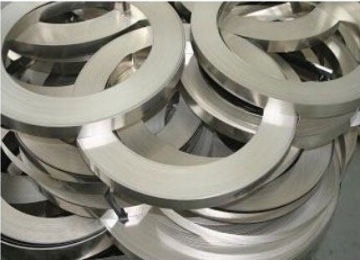
1J79 is a nickel-iron-molybdenum soft magnetic alloy with extremely high initial and maximum permeability, low coercive force, low hysteresis loss, low eddy current loss and low magnetostriction in a low-intensity magnetic field . It is a nickel-iron-based alloy usually composed of about 79% nickel and 21% iron, hence the name 1J79. The main characteristics of soft magnetic alloys are high magnetic permeability and low magnetostriction coefficient, which make them widely used in electromagnetic field and magnetic applications.
Chemical composition of 1J79 soft magnetic alloy
material | 1J79 | ||||||||
chemical composition | C | S | P | Mn | Si | Ni | Cu | Fe | Mo |
≦0.03 | ≦0.007 | ≦0.02 | 0.6-1.1 | 0.3-0.5 | 78.5-80 | ≦0.2 | margin | 3.8-4.1 | |
Mechanical properties of 1J79 soft magnetic alloy at room temperature
grade | Variety | Magnetic properties | |||
Initial permeability u0 (mH/m)
| Maximum permeability um(mH/m) | Coercivity Hc(A/m) | Saturation Magnetic InductionBs(T)
| ||
1J79 | cold rolled strip | ≧31 | ≧250 | ≧1.2 | ≧0.75 |
Rod plate | ≧25 | ≧125 | ≧2.4 | ≧0.75 | |
Physical properties of 1J79 soft magnetic alloy
material | 1J79 | |
physical properties | density | Curie point |
8.6g/cm³ | 450℃ | |
Heat treatment product parameters of 1J79 soft magnetic alloy
The heat treatment of 1J79 soft magnetic alloy is a very important step, which can help the alloy to obtain ideal magnetic properties and softness. The following is the heat treatment process of 1J79 alloy:
Intermediate annealing: annealing at a temperature of 1020~1080°C for no more than 1 hour. This step is primarily to relieve strain and return the alloy to a soft state for further cold working or forming operations. The annealing process needs to be performed in a hydrogen, ammonia, vacuum or inert gas atmosphere to prevent the alloy from absorbing external contaminants.
Final annealing: in an oxygen-free dry hydrogen atmosphere with a dew point lower than -40°C, anneal at 1180°C for 3-5 hours, and then temper. This step is aimed at obtaining the best softness and magnetoelectric properties.
Before annealing, ensure that the surface is cleaned of oil, grease, varnish and other contaminants. During the hydrogen annealing process, inert insulating powders such as magnesium and aluminum oxide are used to separate the different parts to avoid unnecessary contact and contamination.
While vacuum heat treatment can be used, it often results in impaired magnetic properties compared to heat treatment in a dry hydrogen atmosphere.
Metallographic structure of 1J79
The metallographic structure of 1J79 alloy is austenite. Austenite is a crystal structure with a face-centered cubic (FCC, Face-Centered Cubic) arrangement.
In the 1J79 alloy, nickel is the main component of the alloy, while iron is the minor component. This composition gives the alloy an austenitic crystal structure at room temperature. The austenite structure has good ductility and toughness, which makes the 1J79 alloy have good processing performance and mechanical properties in applications.
It is worth noting that the specific metallographic structure of the alloy may be affected by factors such as heat treatment and cooling rate. Different treatment methods may lead to changes in the metallographic structure of the alloy, such as the formation of martensite structure. But usually, 1J79 alloy shows austenitic structure at room temperature
Properties of 1J79 Soft Magnetic Alloy
1J79 soft magnetic alloy is an iron-nickel alloy with high nickel content (about 79-80%), which has the following characteristics:
High saturation magnetic induction: The saturation magnetic induction of 1J79 soft magnetic alloy is greater than 0.75 Tesla (T), which means that the alloy can maintain a high degree of magnetization under high magnetic field.
High initial magnetic permeability: 1J79 soft magnetic alloy has a high initial magnetic permeability, greater than 25 milli-Henry/meter (mH/m), which makes the alloy have good magnetic permeability during the initial magnetization process.
High magnetic permeability: The magnetic permeability of 1J79 soft magnetic alloy is greater than 125 millihenry/meter (mH/m), which means that the alloy has a strong response ability to magnetic field and can realize efficient magnetic energy conversion and signal processing.
Low coercive force: The coercive force of 1J79 soft magnetic alloy is less than 2.4 amps/meter (A/m), which means that the alloy can respond quickly to changes in the external magnetic field and requires less energy when demagnetizing.
Therefore, 1J79 soft magnetic alloy is widely used in many fields, such as inductors, transformers, magnetic cores and sensors, due to its high saturation magnetic induction, high magnetic permeability and low coercive force.
1J79 application range application field
1J79 alloy has excellent magnetic and mechanical properties and is widely used in the following fields:
Pulse transformer
High Sensitivity Relay
Magnetic Amplifiers and Magnetic Controllers
Current Transformer
Iron core for program-controlled telephone
Digital watch stepper motor
High-precision ammeter choke coil and magnetic shield
In general, 1J79 alloy is widely used in the fields of electronics, electrical appliances and automatic control, and plays an important role

